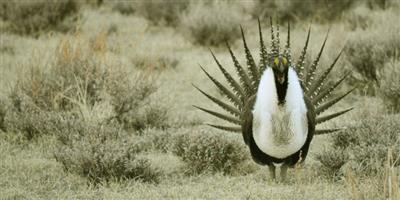WASHINGTON – The Bureau of Land Management (BLM) today moved forward on its collaborative effort to conserve Greater Sage-Grouse and its habitat by issuing Instruction Memorandums (IMs) that clarify how aspects of the BLM’s land use plans will be implemented. These seven IMs relate to oil and gas leasing and development, grazing, and the collection and use of land management data.
“Consistent with our unprecedented cooperation in developing the Greater Sage-Grouse plans, the implementation policies we are releasing today were developed in coordination with our partners in the states and interested stakeholders,” BLM Director Neil Kornze said. “These Instruction Memorandums respond to state and stakeholder desires to see clear and consistent application of our management activities across the western Greater Sage-Grouse states while providing the flexibility needed to respond to local situations and concerns. Although each policy guides the specifics of a single issue in great detail, they all share the same goal of effectively conserving the West’s sagebrush sea for the benefit of the people and animals who depend on it.”
The seven IMs cover:
Oil and gas leasing and development: This IM provides guidance on how the BLM will prioritize oil and gas leasing and development in relation to habitat management areas, consistent with its sage-grouse conservation strategy and Greater Sage-Grouse land use plans.
Grazing permit review priorities: The BLM’s land use plans commit the BLM to prioritize the review of grazing permits that are located within areas that were identified by a team of state and federal wildlife biologists as the highest quality habitat for breeding populations of sage-grouse. This policy provides further guidance on the considerations and process that should inform that prioritization.
Grazing management thresholds and responses: Under the Greater Sage-Grouse land use plans, the NEPA analysis for renewals or modification of grazing permits in priority habitat management areas must consider and may incorporate specific indicators of land health, as well as grazing management responses. This policy provides further guidance as to how and when thresholds and responses should be considered and implemented.
Adaptive management triggers: Most plans contain triggers developed with state wildlife agency experts that require the agency to take pre-defined management actions in response to changes in habitat or populations. This policy details how the BLM will proceed with notification and implementation of identified management actions if triggers have been exceeded.
Disturbance tracking: The land use plans commit the BLM to tracking disturbance and reclamation of sagebrush habitat. This policy guides the use of tracking tools to help ensure the consistent reporting of habitat disturbances and reclamation success across the Greater Sage-Grouse range.
Effectiveness monitoring: This policy explains how data gathered using the BLM’s Assessment, Inventory and Monitoring (AIM) strategy will be pooled to assess how well the BLM is achieving its goals in the land use plans. These reports will use the data gathered under the AIM strategy and disturbance tracking policies and associated monitoring efforts.
Habitat assessment framework: Under this policy, the BLM will use Habitat Assessment Reports to gather information about the Greater Sage-Grouse and the health of its habitat into a single report that allows managers to make accurate assessments of habitat conditions at local, regional and range-wide scales.
The full text of each IM is available at www.blm.gov/sagegrouse in the Documents and Resources section. Detailed questions and answers on the IMs are available here.
On September 22, 2015, the Departments of the Interior and Agriculture finalized the Greater Sage-Grouse plans, which included amendments and revisions to 98 BLM and U.S. Forest Service land use plans across the West. The plans, which were developed in cooperation among local, state and federal agencies as well as private landowners, were cited by the U.S. Fish and Wildlife Service as a key reason it found that the Greater Sage-Grouse did not warrant protection under the Endangered Species Act. Information on the plans can be found here.
Source: Montana and Dakotas BLM
Pixabay photo: CC0 Public Domain


